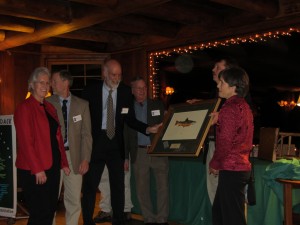
Cliff Kraft, Dan Josephson, Dr. Mark Webster, Kurt Jirka, Barbara Knutz and Marianne Crasny of Cornell, Tom Williams, President of the Adirondack Landowners Association, and Brad Gentry, Adirondack League Club President, during the award ceremony at the Adirondack League Club. Photo by Wende Carr
Cornell University received the Adirondack Landowners Association’s 2012 Stewardship Award during a gathering hosted by the Adirondack League Club in Old Forge on Friday, December 7.
Cornell was acknowledged for its work with the Adirondack Fishery Research Program at the Adirondack League Club where the fishery program was founded 62 years ago.
The award was presented in recognition of the partnership Cornell has had with private landowners, and how that partnership has benefitted the Adirondacks, the State of New York and beyond.
Milestones resulting from this partnership include the development of the hybrid Temiscamie brook trout, which is now stocked by the Department of Environmental Conservation (DEC); acid rain research, which has been instrumental in the Clean Air Act on a federal level; and research to help prevent the spread of invasive species (non-native fish).
Improvement of aquatic ecosystems in the Adirondack Park and enhancement of world-renowned cold water fishery are some of the results of this long-term collaborative research.
One example is that all of the eggs which New York state uses in their hatcheries come from private waters.
This model of citizen-supported, ecosystem and community-based scientific research is one which demonstrates societal benefits of partnerships between private landowners and the research community, according to Tom Williams, president of the Adirondack Landowners’ Association.
“Noone is looking for a pat on the back or a plaque. What we’re looking for is recognition of the role which private landowners have played in the stewardship and protection of the environment, and, to a large degree, the natural resources of the park which we all love,” Williams said.
Among those in attendance was NYS Department of Environmental Conservation Commissioner Joe Martens who addressed the audience by citing the major improvements made within New York and the Adirondack Park in the past couple of years.
In particular, he cited a $103.2 million grant received by the North Country Regional Devel-opment Council and consideration of the construction of a biomass facility in Ray Brook, an initiative which would keep energy dollars local.
He also highlighted the constitutional amendment involving state acquisition of land in Raquette Lake and work toward the acquisition of 65,000 acres for the Forest Preserve.
“One of the crowning achievements is buying the land and making it accessible to everybody,” he said.
According to Martens, most of the new initiatives are coming out of the park itself-from local governments, regional economic development councils and some private individuals.
He commended the ALA “for consistently being a calm, quiet voice in Adirondack matters” and congratulated them for their work on educating the public on invasive species.
Cliff Kraft, a professor in the Department of Natural Resources at Cornell, also spoke of the positive aspects of the decades-long public-private partnership.
“I think it’s very fitting, with Cornell being both a private institution and a state-supported institution. People throughout New York state and across the United States have benefitted from our research,” he said.
Also present at the award ceremony were Dan Josephson, Field Station Manager; Inlet residents Jim and Helen Payne; and Dr. Mark Webster, whose father Dwight was responsible for the inception of the program.
A color print of a brook trout was presented with the recognition award. It will be
hung in a newly renovated science building on the Cornell campus.
